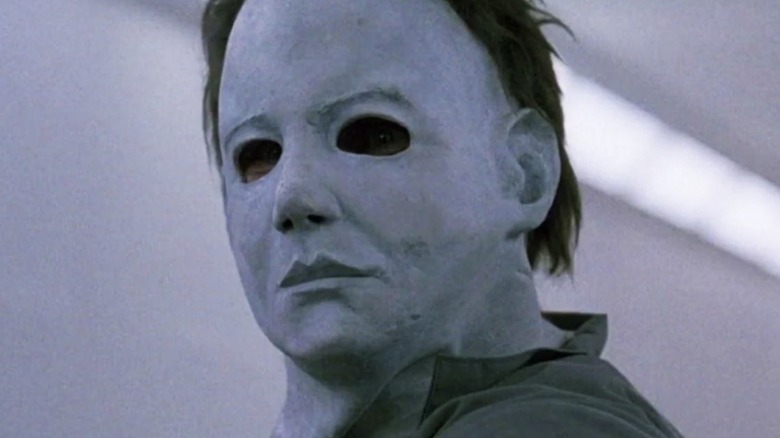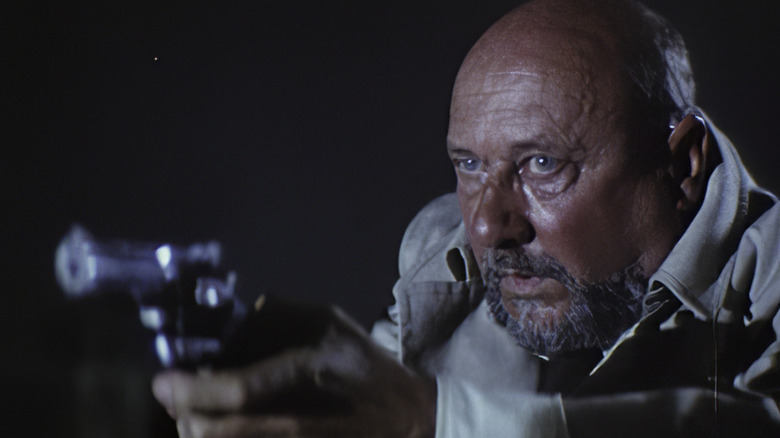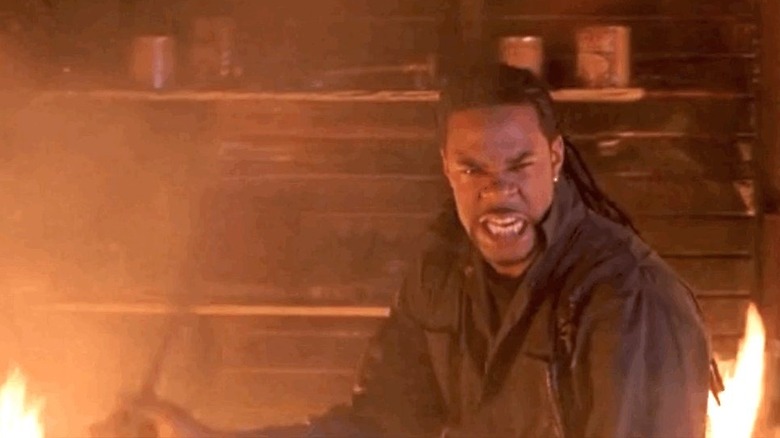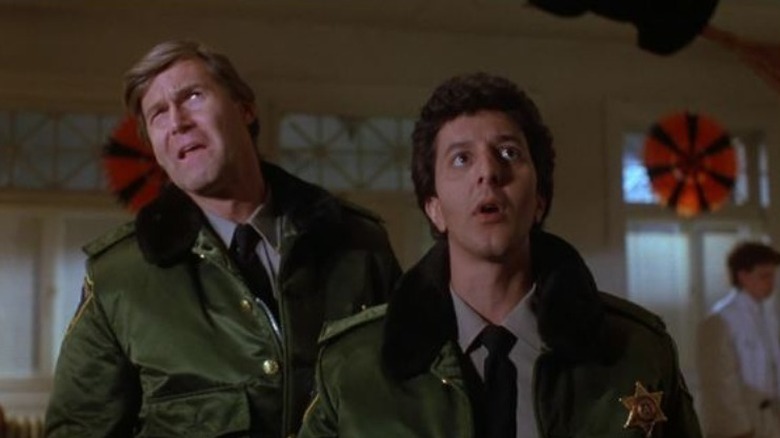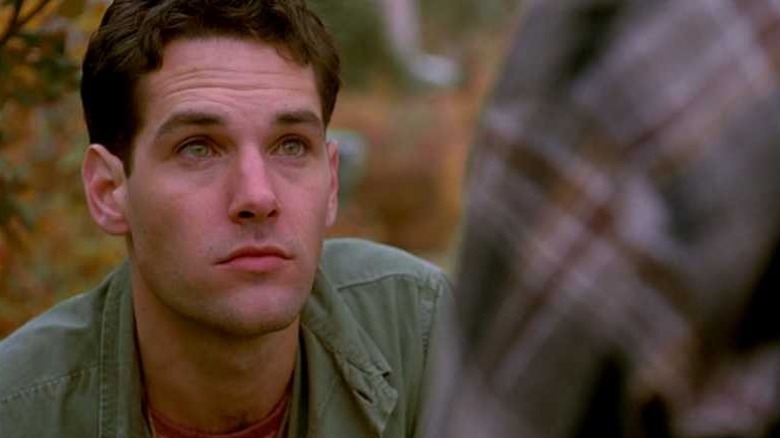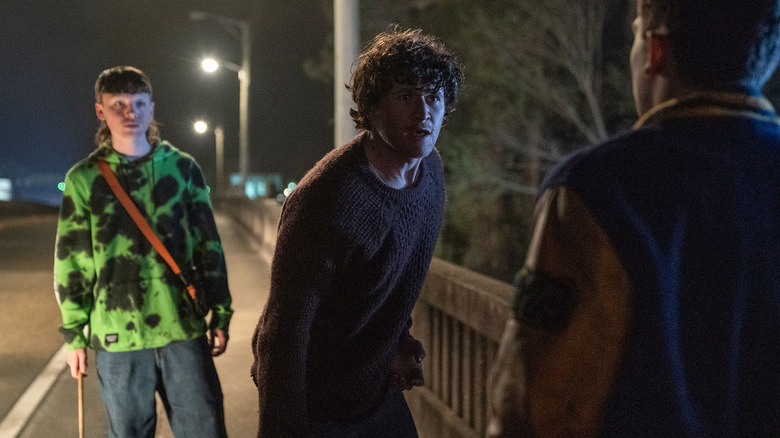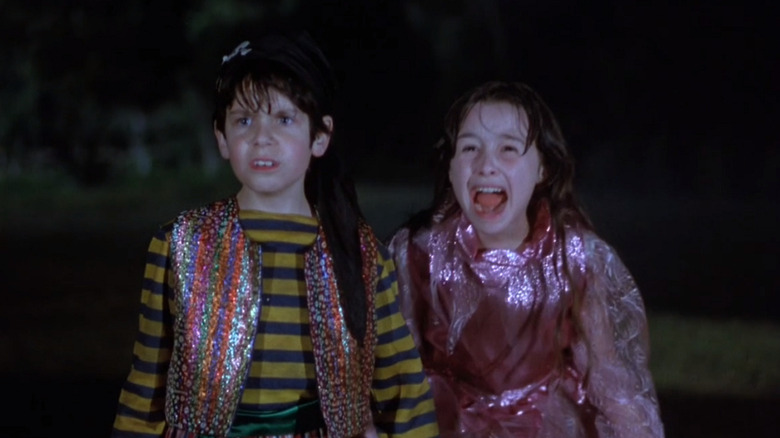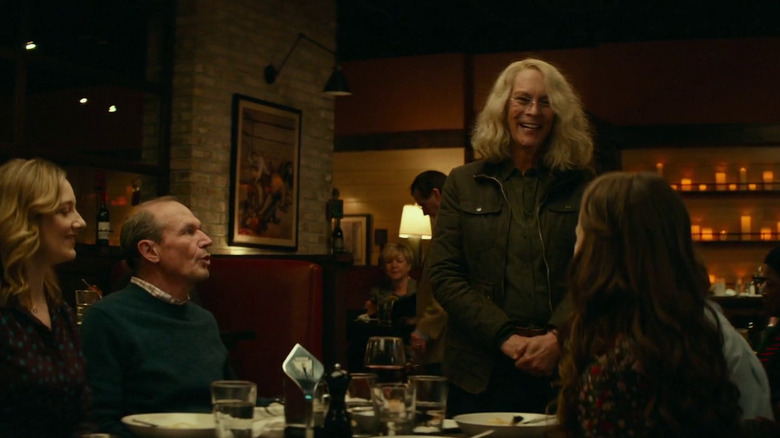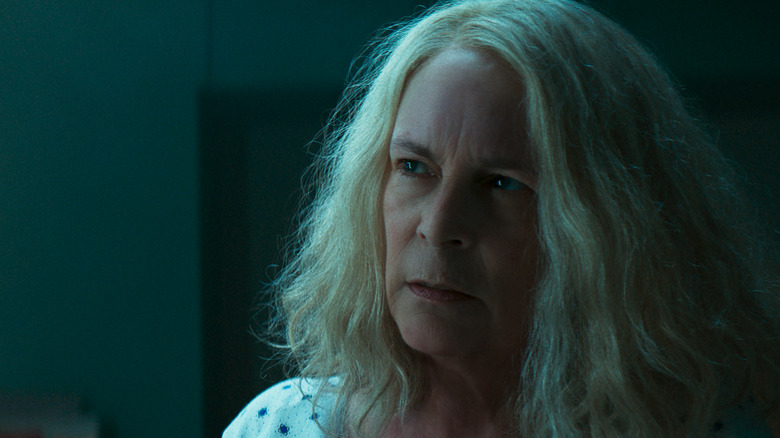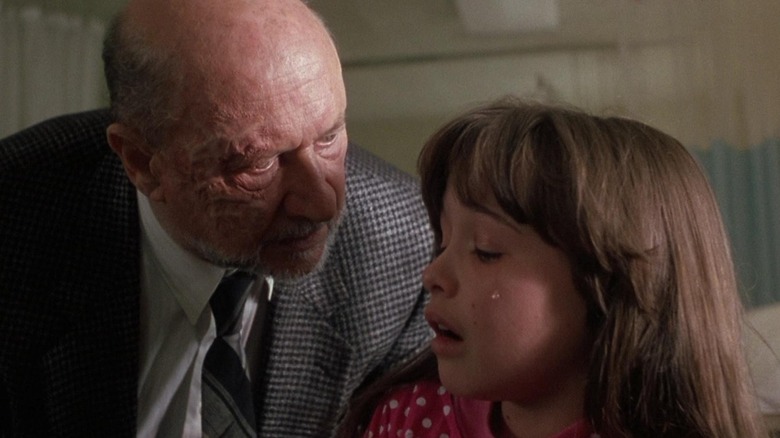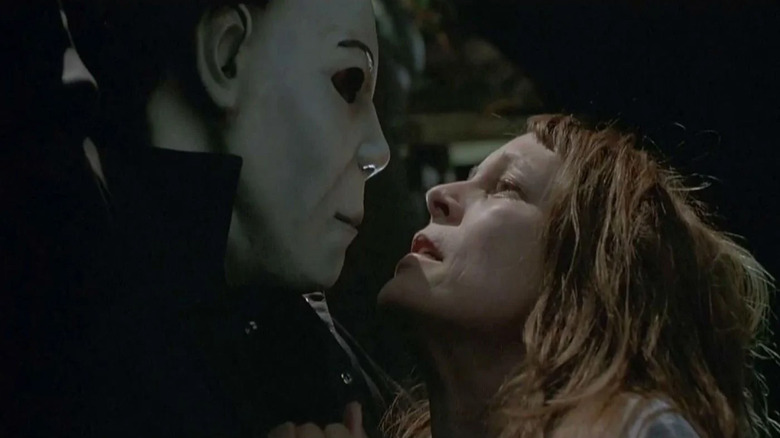The Halloween Franchise's 10 Worst-Acted Scenes Ranked
With the release of "Halloween Ends," the franchise begun by John Carpenter and Debra Hill in 1978 has reached 13 films, officially passing "Friday the 13th" for the horror series with the most installments. In that time, the "Halloween" universe has undergone numerous retcons, alternate timelines, twists, and turns. That leads to a whole lot of messy plot holes and questionable things fans simply choose to ignore, but that's part of the franchise's enduring charm. Even in the worst entries — which many fans would agree includes "Halloween: Resurrection" and "Halloween 5: The Revenge of Michael Myers" — there is some kind of allure to just about any take on Michael Myers' story.
And with a bad film, there will always be bad performances. After "Halloween" became one of horror's greatest achievements over four decades years ago, not even its most beloved characters, like Laurie Strode (Jamie Lee Curtis) or Dr. Sam Loomis (Donald Pleasence), were immune from cringeworthy scenes in later portrayals. It must be said, though, that some of the series' greatest chapters have near-perfect performances from their ensembles. Most of the bad performances in the history of "Halloween" stem from poor writing or conflicting tone, not from an actor's lack of trying.
For the purpose of maintaining proper continuity, Rob Zombie's "Halloween" and "Halloween II" will not be considered in this ranking, nor will the alternate universe anthology entry "Halloween III: Season of the Witch." We're just looking at the 10 films that feature characters from Carpenter and Hill's original vision. That being said, here are the 10 worst-acted scenes in the "Halloween" franchise, from monotone misses to bumbling blunders to child endangerment.
10. Dr. Loomis shot Michael six times ... or was it seven? (Halloween II)
There's an argument to be made that "Halloween II" should not exist. For all intents and purposes, "Halloween" was — and still is — a perfect movie. Hollywood wasn't quite as insistent as it is now on leaving doors open in plots for future sequels, but when Dr. Loomis (Pleasence) shoots Michael Myers (Nick Castle) off of a balcony at the end of that first film, "The Shape" gets up and walks away into the teeth of an eventual sequel.
In that sequel, released three years later, a big chunk of the movie's first half is dedicated to Loomis and the Haddonfield police as they search for Michael (Dick Warlock) around town. When Loomis encounters Sheriff Brackett (Charles Cyphers) and his deputies, he exclaims in an agonized shriek that he shot Michael six times. He reiterates this repeatedly to the point of annoyance, not to mention that Pleasence's acting in this moment seems to be one of particular discomfort, as he nearly labors through the scene.
To add insult to injury, Loomis shot Michael seven times, not six. It has nothing to do with how bad the scene is, but it's a funny aside that not even the writers John Carpenter and Debra Hill could keep a grip on proper continuity here.
9. Busta Rhymes performs martial arts on Michael (Halloween: Resurrection)
Let's put it all out there: director Rick Rosenthal's "Halloween: Resurrection" just might be the worst "Halloween" movie. In reality, it's barely a "Halloween" movie at all. More specifically, it's a satire of the then-budding internet and reality show culture. The young cast that had plenty of budding potential (Thomas Ian Nicholas, Tyra Banks, Sean Patrick Thomas, and Katee Sackhoff are all here), but the movie squanders their talents. If you look at it as a horror movie that just happens to be set in the Myers house, it's an average slasher that sometimes works. But Michael Myers' name and iconic visage are attached to it, making the film the bleakest entry in a franchise full of dull attempts at horror glory.
Perhaps the most befuddling moment in "Resurrection" comes at its conclusion, when "Dangertainment" host Freddie Harris (Busta Rhymes) has a showdown with Michael (Brad Loree) in the Myers' garage. Seeing Rhymes perform karate on the notorious serial killer is almost bonkers enough to work. In execution, though, it's just a modernized, floundering attempt at comedy in a franchise that made its name with terror.
It should be noted, however, that earlier in the film, a Michael-masked Rhymes shares a scene with the real deal. The exchange involves a lot of yelling and ordering the Shape around. It's pretty funny — much funnier and more forgivable than Rhymes throwing roundhouse kicks at an entity deemed unkillable. But we do get a hilarious line from Busta during the fight's climax: "Hey Mikey! Happy f***** Halloween!"
8. Cops search Rachel's house (Halloween 5)
If it weren't for "Halloween: Resurrection," the title of worst "Halloween" movie would probably belong to "Halloween 5: The Revenge of Michael Myers." It's disappointing that the franchise's triumphant resurgence in "Halloween 4" was squandered by such a milquetoast sham of a production less than a year later. "Halloween 4" left us on a cliffhanger that seemed to transfer the evil of Michael Myers to the franchise's new star, Jamie Lloyd (Danielle Harris), the late Laurie Strode's daughter. The final scene of Jamie stabbing her foster mother nearly to death suggested that the next movie would pick up with the young girl following in her uncle Michael's bloody footsteps.
Instead, we regroup with Jamie in "Halloween 5" and learn that she has become mute due to psychological trauma and is now institutionalized. Jamie and Michael now share a telepathic bond somehow, and she can feel when he is about to harm someone she loves. When Myers is in Jamie's foster sister Rachel's (Ellie Cornell) house, she alerts Dr. Loomis, who calls Rachel and warns her to get out of the house and call the cops.
Two deputies (Frank Como and David Ursin) arrive, search the house, find nothing, and strut down the driveway to the tune of literal clown music in the background. They mock Rachel about finding lost pets being their main job, and she's then murdered minutes later by Michael, who was in the house all along. "Fortunately, we're lousy cops," the deputies say later during the movie. "Halloween 5," what are you even doing?
7. Tommy Doyle's cringeworthy obsession with Michael (Halloween 6)
What made the character of Tommy Doyle (Brian Andrews) important in "Halloween" was that even though his worries about Michael Myers were annoying at times, he was right that the Shape had come to his neighborhood. In the end, his belief in the Boogeyman helped Laurie Strode fight off Michael. So when his character is reduced to a creepily obsessive young adult in the sixth film, 1995's "Halloween: The Curse of Michael Myers," it's a bit of a bummer.
Then-newcomer Paul Rudd does do his best in "Curse," but the script doesn't do him any favors. We are reintroduced to Tommy's character when he calls into radio DJ Barry Simms' (Leo Geter) show and explains that he is a survivor who's now obsessed with learning what truly motivates Michael's (George P. Wilbur) killings. Tommy lives in a boarding house and is a profound recluse. Of course, it was a very early role for Rudd and he was still getting his on-screen bearings, but thanks in large part to the production around him, his portrayal of Tommy is mostly cringeworthy and forgettable.
6. The band kids corner Corey (Halloween Ends)
The divisive "Halloween Ends" gets some undeniably great performances out of its ensemble cast — most of it, at least. It's a shame that Rohan Campbell, who gives a franchise-defining performance as nobody-turned-antagonist Corey Cunningham, has to spend multiple minutes in a scene with Michael Barbieri, Destiny Mone, Joey Harris, and Marteen, who play a bunch of high school band kids wanting to score some alcohol via Corey and his of-age status.
Terry (Barbieri) attempts to intimidate Corey into buying him and his friends some beer, but Corey — who, after his involvement in the death of a young child he was babysitting, is trying to piece his life back together — refuses to risk any trouble. Barbieri doesn't sell the taunts well, coming off like a thespian desperately trying to impress his friends by picking a fight with someone in his mid-20s. Not to mention, Harris, a white actor, embarrassingly employs an unnecessary amount of AAVE in his own dialogue. Most of "Halloween Ends" is well-acted. This exchange? Not so much.
5. Jamie and Billy fight to get a word out (Halloween 5)
As director Dominique Othenin-Girard explained in an interview with HalloweenMovies.com, "Halloween 5" went into production without a finished script. It shows. What the movie does to the character of Jamie Lloyd is unforgivable. Danielle Harris, arguably the third-most-talented cast member in the entire franchise (after only Pleasence and Curtis), truly does her best to salvage the role, but no one could have saved the mess of "Halloween 5." At one point, the plot hinges on its mute child protagonist experiencing potentially dangerous visions, and the only person who can translate them to the police for her is another child, Billy (Jeffrey Landman), who also happens to have a severe speech impediment.
It's possible that the writers wanted to forge some kind of bond between two children who are seen as pariahs because of their respective disabilities, but it misses the mark. In reality, it was most likely an ignorant attempt at making the demises of central characters take just a few beats longer to happen. Granted, the friendship between Jamie and Billy is one of the few bright spots of "Halloween 5," but Landman and Harris are forced to perform scenes with as much exaggeration as they can possibly exude into their dialogue (or, in Jamie's case, lack thereof).
As Rachel's best friend Tina (Wendy Foxworth) is in danger at a local corner store, Jamie begins having a vision of her imminent murder. But by the time Billy can fully translate that Jamie is saying "cookie woman," marking Tina's location near a prominent advertisement, the scene has grown into a truly. uncomfortable watch. The audience is tasked with feeling sympathetic toward two kids cajoled into performing the most-overacted and unnecessary two-word line in horror history.
4. Karen drags Laurie in front of Allyson (Halloween 2018)
Judy Greer is one of our greatest living actors, that much is true. But in 2018's "Halloween," as Laurie Strode's daughter Karen, Greer gives the worst performance of her career. Most of her lines are delivered with a grating, monotone voice that fails to emphasize the trauma that Karen has supposedly lived through as the daughter of an overprotective and highly paranoid Laurie.
The worst moment for Greer in this movie comes at a dinner attended by Karen, her daughter Allyson (Andi Matichak), husband Ray (Toby Huss), and Allyson's boyfriend Cameron (Dylan Arnold). When Laurie shows up drunk and mid-breakdown after witnessing Michael's (James Jude Courtney) prison transfer, Karen decides to tell Allyson about why she and Ray prefer to not have Laurie in their lives. A monologue follows about how Laurie taught her to shoot guns and protect herself at a very young age, always preparing for Michael's return.
Greer has given much better performances throughout her career, and in a franchise that so often goes over-the-top, her performance is too one-note and too restrained. It's a character misfire that Greer didn't get much of a chance to reconcile before her character was murdered in "Halloween Kills."
3. Laurie's monologue about evil (Halloween Kills)
"Halloween Kills" is a mess. When the writers of the latest "Halloween" entries revealed that they were making a trilogy, "Kills" started the race 10 laps behind. With audiences knowing another film would follow it, the most intense moment of "Kills" — in which Michael is beaten to the brink of death — holds no water, because everyone could infer that he'd survive the attacks. There a lot of cringeworthy scenes with subpar acting in "Kills," especially among Tommy Doyle's (Anthony Michael Hall) "evil dies tonight" tangents, but the worst offender belongs to the franchise's most beloved character, Laurie Strode.
The mere idea that the worst-acted scene of any "Halloween" movie would be one of Jamie Lee Curtis' is baffling, but even she has her share of rough moments across her eight appearances in the franchise. Bedridden and wounded in a hospital while Michael wanders the streets of Haddonfield, Laurie closes the film with a monologue about the "essence of evil." It feels out of place that a character, even the star of the show who has been inactive for much of the movie, is given the responsibility of delivering the supposed emotional climax of its narrative. But Curtis labors through an exposition-heavy speech about how Michael will always exist and that fear is undefeatable. It's a scene that feels forced, unnecessary, bland, and too over-the-top for its own good, meant to give some profound meaning to Michael's motivations and set the scene for "Halloween Ends."
2. Dr. Loomis puts Jamie in danger (Halloween 5)
There's a clear moment where it's painfully noticeable that Donald Pleasence had lost a step or two in his portrayal of Dr. Loomis. After a career resurrection one year prior in "Halloween 4," he returned as a caricature of himself in "Halloween 5." Once a calm and collected doctor who knew he could find Michael if he just played his cards safe and quiet, Loomis eventually has become a loose cannon by "Halloween 5," acting on a short fuse and making impulsive choices just to stop Michael. It's not a surprise, given that he'd spent a decade on and off trying to prevent Michael from killing more innocent people and had failed to stop him three times already. Pleasence's performance, however, bears the tragic touch of a great but aging actor beginning to lose touch with a character that's defined his career.
In "Halloween 5," after spending the entire movie yelling at her, Loomis makes the head-scratching and worrisome choice to use Jamie as bait in catching Michael (Don Shanks), since Michael's motivations are to kill everyone in his own bloodline. How the idea of Loomis using Jamie as bate made it into the movie is mind-boggling, given that Jamie is just a child. It works for the moment, as a steel net drops onto Michael and puts an end to his murderous spree, though he's eventually freed by the mysterious Man in Black (also Shanks) while imprisoned at a local police station.
Pleasence would again get a chance to redeem the character of Loomis six years later in "The Curse of Michael Myers." He mostly succeeded, giving his final performance as Loomis a certain quiet dignity. But the creepy, overzealous damage done in "Halloween 5" taints the doctor's legacy.
1. Laurie kisses Michael before he kills her (Halloween: Resurrection)
Though Busta Rhymes performing martial arts on Michael Myers is one of the franchise's worst moments, "Halloween: Resurrection" commits an even worse cardinal sin: killing Laurie Strode. A few years prior, in "Halloween: H20," Laurie finally defeated Michael by decapitating him, allowing her to finally bring closure to their shared story. In "Resurrection," the writers completely retcon the "H20" finale and present a cold open in which Laurie, now institutionalized, squares off with Michael one final time on the hospital's roof.
Initially, it seems that Laurie has outsmarted Michael again. But, unfortunately, her desire to unmask him leads to him getting an upper hand and throwing her off the roof to her death. He gets one knife stab in there, too, and shortly before she falls, Laurie kisses Michael on the lips of his mask before telling him she'd see him again in Hell. The ending of "H20" was perfect: Michael was dead; Laurie could begin to truly live her life free of his evil. But "Resurrection" did the unthinkable by killing off the franchise's star, and in the first ten minutes of the movie, no less. In what can only be assumed was an act of protest against her character's unceremonious exist, Jamie Lee Curtis delivers an anomalously hollow performance in her final moments as Laurie Strode — until 2018, when the events of "Resurrection" were nixed, and her story was again rewritten.
